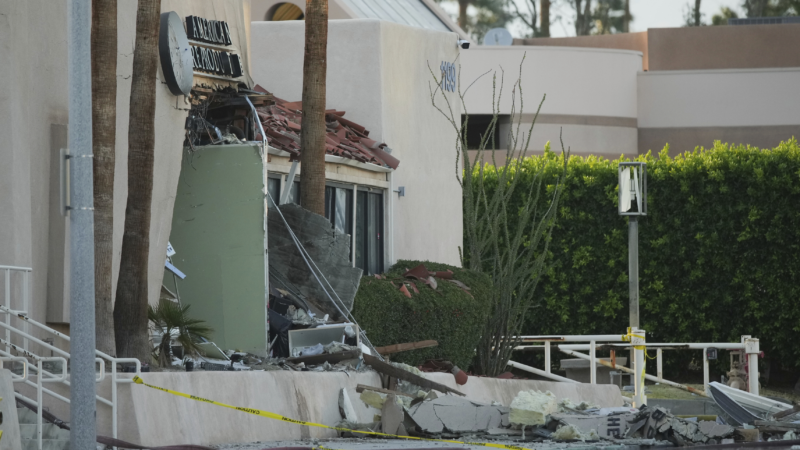Losing History in One of Birmingham’s Oldest Neighborhoods
Birmingham city leaders are stepping up efforts to deal with dilapidated or abandoned properties. In communities overshadowed by blight, preservation is rarely an option, since resources are devoted to cleaning up and demolishing hazardous properties. In these neighborhoods, residents want to document the past before it’s destroyed.
A Crumbling History
Andre Brown drives a blue pickup through the Fountain Heights neighborhood of Birmingham where he’s lived almost all his life. There are striking views of downtown from all around this hilltop community, and Brown says every home he passes tells a story.
“See I know that’s an old historical building that’s gonna be torn down — it’s already on the demolition list,” he says. “You can tell by the masonry of the brick that the homes are old.”
Brown points to one of the Victorian homes that line the streets of Fountain Heights. Many of its historic buildings were built in the 1800s. They feature double chimneys and wrap-around porches, and for years they have been falling apart. He says that when he moved to the community as a small child in 1966, things were different.
“The area was really a beautiful area,” he recalls. “It was kept clean, paved roads. People could almost, back then, leave your front door open sometimes. But then times changed.”
The Frontline of Desegregation
The abandoned homes in Fountain Heights are some of the oldest in Birmingham. University of Alabama at Birmingham (UAB) Assistant Professor Pamela King has surveyed its historic buildings. She says the neighborhood “has some histories that are absolutely unique in the city, so when it’s gone, it’s gone.”
According to King, it began in the 1880s as a Jewish community. Jews eventually migrated out, and by the 1940s, it was a working class white neighborhood. Middle-class blacks began to move into the area, crossing over from Smithfield. Local white supremacists and the Ku Klux Klan tried to keep blacks out of Fountain Heights, but things changed in 1964 when segregation became illegal.
“I think of it as the frontline of Birmingham’s desegregation,” says King. “And there’s a huge wave of African-Americans who move in right that year. I interviewed some and … by 1969, 1970, according to Birmingham Census and Records, it’s 100 percent Black.”
Abandoning Neighborhoods
Around this time, construction began for Interstate 65. It cut directly through Fountain Heights and the neighboring community of Enon Ridge. Andre Brown remembers the impact it had.
“The highway came in when I was a kid,” he says. “That cut off the black communities then and it kind of destroyed a lot of beautification that was in Fountain Heights.”
By the 1970s, Fountain Heights was surrounded by interstate on three sides and property values declined. Middle- and upper-income black families began to leave the area. John Colón, the Birmingham’s community development director, says these outward migration patterns occurred throughout inner-city Birmingham.
“We’ve lost a third of our population essentially over the past 50, 60 years,” he says. “And as folks left the city, they left sort of a surplus of housing.”
Housing Discrimination
In addition to population loss, Colón says the current issue of vacancy can be traced to housing discrimination. “We found these old maps that were actually produced by the city’s planning department.”
These “red line maps” divided the city into areas deemed “best, desirable, hazardous” and those with “negro concentrations.” Colón says local banks and financial groups used the maps to discriminate against African-American homeowners. “When we take those areas and overlay them over today’s blight conditions, we see that it’s those same areas that were deemed “negro concentrations” that are now the most blighted communities in the city of Birmingham,” he explains.
Unintended Consequences
The city is now trying to address the problem, using $6.5 million to tear down or maintain vacant properties.
In Fountain Heights, Andre Brown says many historic homes are beyond repair, but he hopes the history will not be forgotten. Continuing the drive through his neighborhood, Brown points to structures across from his own house:
“The KKK either met in the building right here on the corner – the Klan did. It would be either that one, or this building right here.”
Fountain Heights is just one of 99 neighborhoods that make up the city of Birmingham, each with a unique story. Brown thinks the government should devote more resources towards historic preservation.
“We’re still struggling here to preserve Fountain Heights,” he says. “And federal money needs to be put into these old neighborhoods.”
In communities like Fountain Heights, residents look forward to change. But with each vacant home that’s demolished, they risk losing touch with the very history that led to the problem.
Low prices and Trump’s trade war are pushing these Northwest farmers to the brink
Almost all of the wheat grown in the Pacific Northwest is for export, and even before President Trump's trade war, farmers were dealing with rock bottom prices and slagging global demand.
Centrist wins Romania’s tense presidential race over hard-right nationalist
A huge turnout Sunday played a key role in the tense election that many viewed as a geopolitical choice between East or West.
Former President Joe Biden diagnosed with prostate cancer
Biden has been diagnosed with prostate cancer, which has metastasized to the bone, according to a statement from his personal office.
A deadly explosion outside a California fertility clinic is investigated as terrorism
One person was killed and four were injured in the weekend blast, said Akil Davis, assistant director in charge of the FBI's Los Angeles Field Office.
SNL’s 50th season proved it’s still relevant. Can it stay that way?
The season finale, with host Scarlett Johansson and musical guest Bad Bunny, didn't give any answers about rumored cast departures.
Zelenskyy meets Vance in Rome, hours after Russia’s largest drone attack on Ukraine
The intensified diplomacy came as Russia launched its largest drone barrage against Ukraine since the start of the full-scale invasion in 2022.













